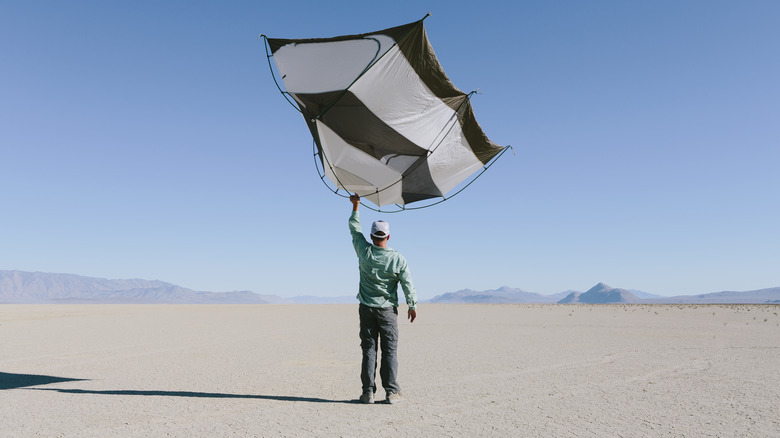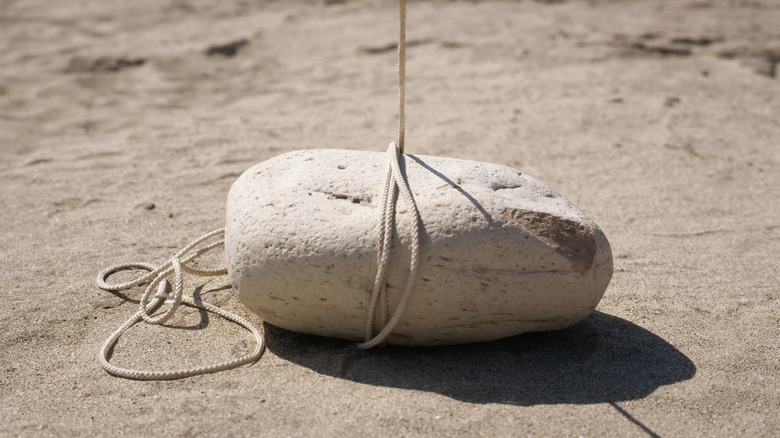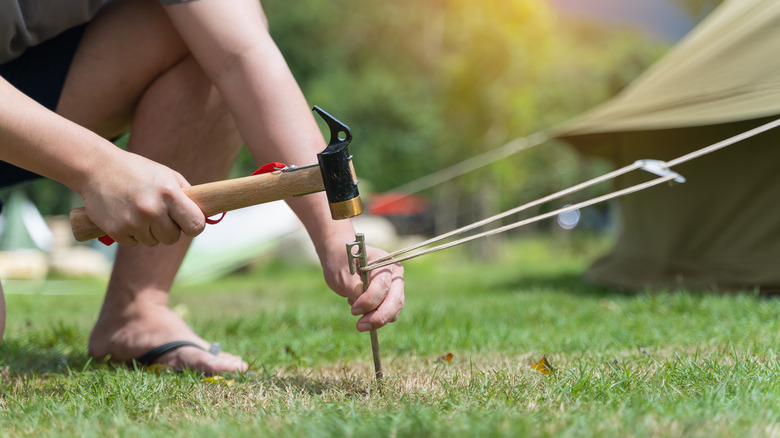What It Means When Someone Recommends Using A 'Deadman' When Tent Camping
So, you want to set up a tent. No problem! Spread out your ground sheet, unfold the fabric, and slip the poles through their sleeves and clips. After you've pitched the tent, take the "grommets," or little rings at each corner, and fasten them to the ground with stakes. Rest the limp rainfly on top, then take its cords and stretch them toward the ground, where you'll use additional stakes to keep it taut. Voila! Your tent is ready. Good thing you've chosen the right tent for your camping adventure.
What's that, you say? The terrain is loose sand, and the stakes won't stay in the ground? The weather calls for heavy winds, and your rainfly has already been ripped off the tent's roof? The storm is picking up, and the only thing keeping your tent from blowing away completely is the heavy backpack you stored inside? Now you're chasing after your sand-caked belongings, but rain has started pattering the beach, and whose idea was this anyway, why can't you just go home?
Okay, this is a worst-case scenario, but it's not beyond the realm of possibilities. Nailing your tent in place is a deceptively important step, especially in advance of inclement weather. But what do you do when the soil is soft? Those stakes (also known as pegs) may not even stay in the ground, much less hold your shelter in place. What this scenario calls for is a "deadman anchor" — in short, a heavy object buried in the ground.
When you should use a deadman anchor for tents
Yes, "deadman" is an unsettling name for anything related to camping, but the phrase makes some macabre sense: This anchor is fashioned out of any heavy object, usually a rock or chunk of wood. Once you've figured out where you'll set up your tent, dig shallow holes in the ground where the stakes would be placed. If your tent has grommets, tie rope through the loops or rings, then tie the rope firmly around your anchors. Place the anchors in the holes, then use the soil or sand to bury them. If they're heavy enough — and sufficiently covered — they should remain in place, keeping your tent up even in significant winds.
Deadman anchors are extremely handy in sandy settings, either on a beach or in a Sahara-like desert, where the ground is soft and gales can get intense. They're also useful in a very different environment: heavy snow and ice. Mountaineers often find themselves on ice fields or glaciers, where the ice is thick but also resistant to traditional stakes. Once you get above tree-line, you won't find vegetation, and rocks may also be covered, so some mountaineers use bits of equipment, such as skis, to stabilize their tents. Similar techniques could be used on frozen lakes or snow-covered flatlands.
Note that most established campgrounds will have more welcoming terrain, and even primitive campsites in state parks are usually designated with care. You'll probably have to stray from the beaten path to camp on dunes or barren ice sheets, so only the most ambitious campers should ever need deadman anchors. Still, it's a great hack, and you could easily add it to a list of survival skills everyone needs to know.
Why deadman anchors are a last resort
There's another reason most people shouldn't use deadman anchors, except as a last resort: the very act of digging holes in the ground. If you're camping in a remote location where there is no plumbing or outhouse, you should plan to dig a "cathole," or primitive toilet, which is designed to bury excrement. But as the U.S. Forest Service notes on its website, campers should seek out established sites wherever possible and try not to disturb the area any more than necessary, due to soil erosion. Digging any sizable holes and moving rocks around can affect the topsoil and lead to unpleasant runoff. Unfilled holes may result in puddles and still water, which are breeding grounds for mosquitoes. The less you have to dig, the better.
Snow and ice are different, of course. You can shovel away at frozen water and not cause any serious damage, and any precautions you would take — against ice collapse or avalanches — should always be on an alpinist's mind, whether camping or actively climbing. Planting these anchors does take work and practice, so you'll have to decide whether you absolutely need them. But if the right circumstances arise, a deadman can be a real life-saver. While you're streamlining your outdoors skills, here are things to remember to do before leaving your campsite.


